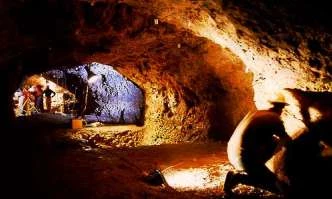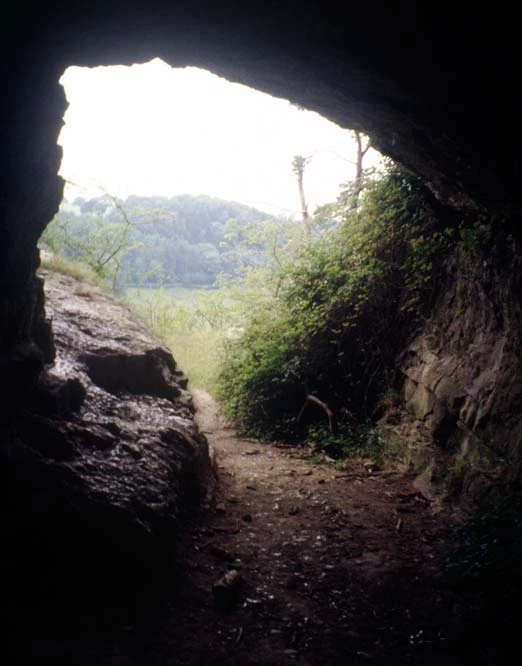The Caves at Cefn: Tales of strange creatures and evidence of Wales's earliest humans.
The complex of caves found at Cefn, just outside St Asaph in north Wales, has been the focus of much interest over the years. Full of animal bones and home to early Neanderthals , the caves have drawn many notable visitors, including Charles Darwin in 1831.
Pontnewydd Cave excavations
Teeth from Pontnewydd cave
Pontnewydd Cave
Cefn Cave looking out
The caves in the parish of Cefn Meiriadog, Denbighshire, have long been places of interest for scientists, artists, poets and antiquarians. The Denbigh to Abergele road once passed through the rock arch beside the River Elwy and many people stopped here to enjoy the beautiful scenery. The antiquarian John Leland wrote about Cefn during the 1530s 'On the farther ripe of Elwy a 3. or 4. miles above S. Asaphes is a stony rok caullid Kereg the tylluaine, i.e. the rok with hole stones, wher a great cave is, having divers romes in it hewid out of the mayne rok.' Writers Thomas Pennant, Richard Fenton and Edward Pugh were among many visitors to the Cefn Caves in the years before 1830.
Bones in the mud
Charles Darwin visited Cefn in August 1831 during a geological tour with Professor Adam Sedgwick. Darwin described the limestone at Cefn and an entry in his notebook observes that Sedgwick spotted rhinoceros bones in mud in the cave; Sedgwick's notes state that a rhinoceros tooth was found. Unfortunately neither commented on the palaeontological significance of the find. Which cave did Darwin visit? Cefn Cave is the more likely, as records of a visit by the Reverend Edward Stanley the following year inform us that landscaping had left 'bones in the mud for the taking' and that many bones were spread as fertiliser on the fields below. Stanley recorded seeing a rhinoceros tooth in the landowner's collection - could this be the tooth found by Sedgwick and Darwin? We shall never know for sure.
Hippopotamus, Rhinoceros and Elephants
Stanley described the landscaping of Cefn and the construction of walks through the valley which involved removing some of the projecting areas of cliff face on Cefn Rocks. A series of gentle steps and staircases were created from the valley bottom and through Cefn Cave. Huge quantities of deposit were removed from the cave to create a single passage connecting the two cave entrances. Stanley excavated within Cefn Cave in 1832. He found bones of straight-tusked elephant,
rhinoceros and hippopotamus of last interglacial age (c. 125,000 years old), and deposits that interested many geologists and other scientists who visited the caves.Debates about the antiquity of humans and their relation to extinct animals were raging in the learned societies at this time. So an article that appeared in The Times on 20th October 1870 claiming the existence of a strange amphibian living in Cefn Cave caused considerable interest. It called upon naturalists to investigate the survival of an ancient creature in North Wales. The Flintshire Observer for 4th November 1870 told a tale of a living lizard, four feet seven in length and very much like a crocodile which had emerged from the depths of Cefn Cave. This lizard had reportedly been slain by a valiant Welshman, Mr Thomas Hughes, chimney sweep of Rhyl. The tale as retold suggests that the crocodile did not reach Cefn at all: it apparently died whilst a part of a travelling menagerie visiting Rhyl. On learning of this Mr Hughes ingeniously devised the tale of its capture in the cave and having purchased it proceeded to show it as the marvellous lizard of Cefn.
Pontnewydd Cave
In 1872 Professor Sir William Boyd Dawkins visited Cefn and excavated
Pontnewydd Cave . This cave was noted by Stanley as being completely undisturbed when he found it on the valley side a little to the north-west of Cefn Cave. Stanley did not excavate here, but it is believed that the local rector Reverend Thomas, Mrs Williams Wynn (the landowner), and Boyd Dawkins did. In 1874 Thomas McKenny Hughes undertook more extensive work in the cave during which he discovered an exceptionally large human tooth associated with stone tools and animal bones.The Cefn caves were then largely ignored until the 1940s when the army turned Pontnewydd Cave into a store for landmines and depth charges, building the limestone wall, steel doors and guard chamber, with its coke stove to keep the watchman warm. Cefn continued to be a place people would visit, spending Sundays and Bank Holidays exploring the caves.
In 1978 the national museum commenced a research project investigating the caves of Cefn starting with excavations in the Pontnewydd Cave and later at Cefn. Pontnewydd has become a site of international importance containing the remains of an evolutionary early form of Neanderthal who used this cave some 230,000 years ago.
Today the caves lie on private land belonging to the Cefn Estate and are not accessible to visitors.




Comments - (17)
If it was private land as youngsters we took no notice.
Didn't know about the history of the place.
It was just a place to lark about
Hi James Harrington,
Many thanks for sharing your story of your experience at Cefn in the late 1960s. The caves at Cefn are very special to many of us. Indeed they do lie on private land without a public right of way. These caves are really important and as such they are protected as sites of special scientific interest for the nature and geology as well as being scheduled ancient monuments for their archaeology. The path to Cefn Caves was especially difficult on the last occasion I visited. The Victorian walkways cut into the limestone have eroded, as is to be expected, and some stretches were quite hard to navigate, even with a guide from the estate.
Kind regards,
Elizabeth Walker
(Specialist Curator for Palaeolithic & Mesolithic Archaeology)
from Henllan to "Cefn Caves", there to meet others from surrounding villages
and hamlets.
Picnics galore whilst some explored the caves and others visited the tiny pub
near the river Elwy.
Don't believe all the gossip about Free Access to the cave area - the Landowner
held a tight grip on the land, the tied-cottages and even the generation of
electricity powered by (his) tiny water-powered generator.
It was only sheer numbers which broke the "Trespassers will be Prosecuted"
claim on that day.
Being predominantly limestone, the whole area was riddled with small caves which
we Bachgen Henllan explored with dim torches and candle 'ends', led by the intrepid
Arthur.
Moderator's note - can we put to bed the complaints about access to the site, and stick to discussion about the finds in question, please?
At the moment, we are working hard to prepare these amazing finds from Cefn for display this Autumn at St Fagans National Museum of History - which is free to visit and open 362 days a year. We hope to see you there,
Moderator
Amgueddfa Cymru - National Museum Wales